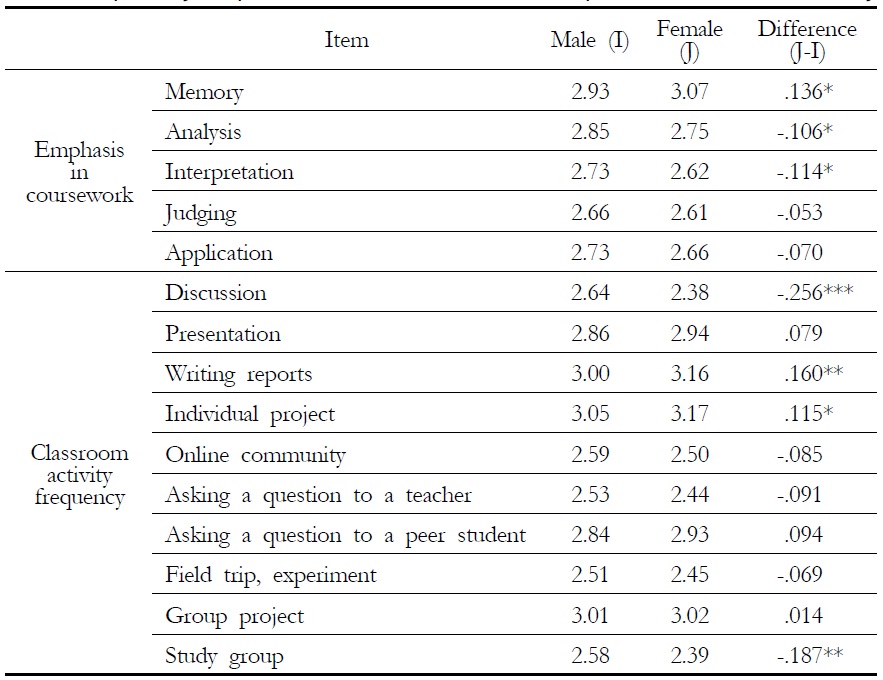


With the spread of further and higher education and of gender equality, the likelihood of women continuing and completing higher education has reached approximately the same level as for men. In terms of the quantity and quality of employment, the achievement of women graduates has greatly improved. In areas where selection exams are in place (for example, the Korean Bar Exam, the selection exam of civil servants and the teaching qualification exam), women’s achievement has been particularly outstanding, giving an impression that the issue of gender discrimination in the labor market has been resolved or perhaps even that female graduates seem to have a better chance for employment than male graduates.
However, in terms of the overall employment rate and the quality of employment, gender inequality still exists in a way that disadvantages women (Shin, Jeong, & Ku, 2008; Shin, 2010). For example, the observation of women graduates following their graduation in 2005 reveals that, within three years of their graduation, their employment rate was consistently lower in comparison to their male counterparts by approximately nine percent. Women were also 10 percent more likely than men to be employed at Small and Medium Enterprises (SMEs) or as temporary workers.
What contributes to the persisting issue of gender inequality? While there may be external factors such as gender differences in the dominant subjects of their university major, androcentric organizational culture, and the prejudice against women workers, internal factors also play a role including women’s adaptability to organizational cultures and their work ethic.
Since the late 20th century, the rapid development of modern technology and globalization has resulted in a rapidly changing labor market, with accelerating changes in the types of jobs and roles. Paradoxically, the labor market demands more universal and core competencies of workers (OECD, 2004). Core competencies are the transferable skills and aptitudes that are demanded from every job and industry. As terms referring to core competencies, generic skills, essential skills, and basic competencies are utilized by researchers and international organizations without a formally adopted definition of core competency. Thus, in this study, core competencies are not considered to be different from essential skills, generic skills, or basic competencies. While there is debate over what can be listed as core competencies, lists generally include cognitive and attitudinal competencies such as communication skills, interpersonal and cooperative skills, higher-order thinking, mathematical competency, and resources-information-technology processing & application skills.
In fact, company-level analysis of the competencies of human resources shows that management considered the core competencies of graduates most important and yet, they still left much to be desired (Chae, Ok, Choi, Kim, & Oh, 2005; Chae, Park, & Lee, 2006). In the changing labor market, the demand for core competencies has focused attention on the development of these competencies in higher education. For students in higher education, it has become important to build their core competencies in order to prepare themselves for the job market.
Since core competencies are the basic and universal skills that are required for women students’ success in their career, the analysis of the level and types of their core competencies needs to go beyond academic research. The analysis is also necessary for informing policies towards encouraging women’s career advancement and gender equality. Based on an analysis of women’s core competencies and their advantages and disadvantages in the labor market, it is possible to provide improved support to women in building their core competencies, including the design of a competency-building program and the provision of training courses.
The importance of core competency in promoting successful career advancement is receiving increasing attention, but nobody has yet investigated university students’ levels of competency, what differences environmental factors may make, and whether the competency of students may differ depending on the university courses they take. In order to improve the core competencies of students and universities, the level of existing competencies and the competencies’ pros and cons should be examined but so far, no effort has been made to do so. This is one of the major reasons why the importance of core competencies has only recently been highlighted and the tool to assess them had not yet been developed.
The Korea Collegiate Essential Skills Assessment (K-CESA) is an examination tool that was developed through research conducted between 2006 and 2010 under the financial support from the Ministry of Education, Science and Technology. In order to define the list of core competencies, literature review and expert Delphi analysis were conducted to identify six competencies. Diverse groups of experts and professionals, including the Education Assessment Society and company HR experts, collaborated to develop this tool. (Jin, Lee, Chae, Yu, Park, & Lee, 2007). K-CESA examines the competencies of university students and provides the foundation for the development of skills development programs.
This research will use K-CESA to examine women students’ core competencies and draw implications for women’s competency development. Three research questions form the primary purposes of the study:
First, what are the current levels of male and female university students’ core competencies?
Second, what gender differences exist in the level of these core competencies? How do women differ from men in terms of their core competencies? What are their strengths and weaknesses? Third, what factors play a role in determining the level of women students’ core competencies? How do university, grade, family background, academic achievement, and subject domain relate to the level of core competencies?
In order to examine the core competencies of women students, K-CESA results are statistically analyzed using t-test and analysis of variance (ANOVA) for mean comparison between genders. The gender differences are also tested using multiple regression to examine whether significant gender differences remain after controlling for students’ backgrounds. K-CESA is a web-based tool to examine the level of six core competencies. Table 1 shows the components of the six core competencies and how they are examined.
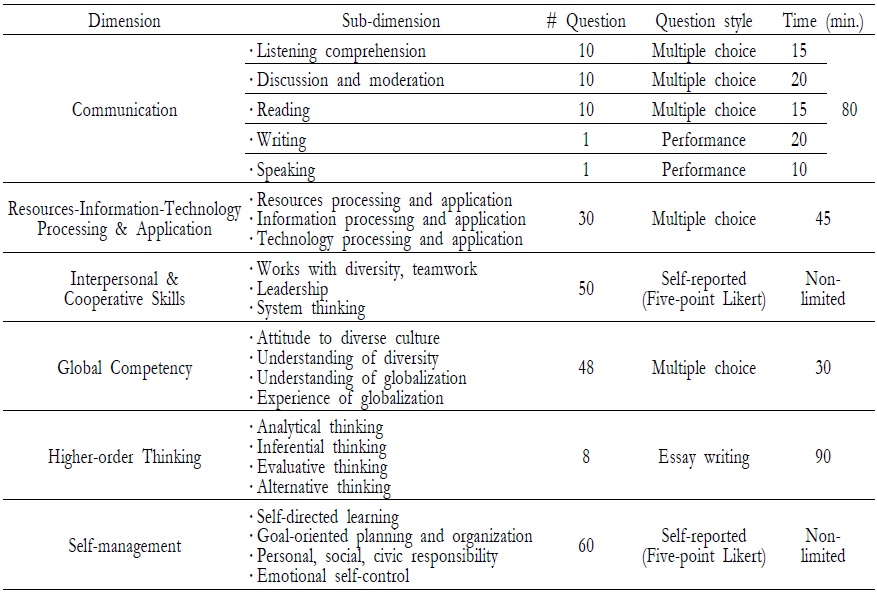
K-CESA Questions
For example, for communication skills, students have to speak about their opinion via microphone after listening to a problem situation occurring in the workplace. For RIT skills, students have to choose the correct answer to a question such as ‘How can you interpret the figure and table on market share?’
This study is a secondary analysis on the raw data of the K-CESA and additional survey administrated in 2009.1 One thousand and sixty nine male and female participants from nine different universities took K-CESA during December 2009. An additional survey of the curricula and programs related to the core competencies at universities was administered to students who took the K-CESA.
Although the original sampling frame was made to include public and private universities from different regions within South Korea, the sample was not perfectly representative, so there are limitations in generalizing the interpretation of the results. While this gender comparison study by using K-CESA tool is focusing on the question whether there are gender differences in core competencies, this study cannot examine what factors are responsible for any gender differences that may exist. Because this study does not employ experimental or longitudinal methods, it is also limited in the causal conclusions that can be drawn.
1The instruments, methodology, and initial descriptive statistics of 2009 K-CESA were reported in the study of Jin, Lee, Lim, & Yu (2009) that had been supported by the Korean Ministry of Education, Science and Technology.
>
The Concept of Core Competency and Its Components
Various terms are used in previous literature to refer to core competencies including: foundation skills, competency, essential skills, generic skills, key competencies, life skills, and core competencies. The concept of core competency was not introduced through systematic academic research, but rather, the concept is general and commonsense. Some examples of prior inventories of core competencies include:
While there are many different terms for, and definitions of, core competency, all of them have in common that a core competency is a necessary and essential skill for work life. A core competency is not something that is particular to certain jobs and roles. Rather, it is a skill that every worker should have regardless of their occupation and role. Consistent in the previous literature is that this competency does not refer to knowledge or technique in a narrow sense but it is comprised of a complex combination of factors including the core human qualities, attitudes, aptitudes, problem solving abilities, and interpersonal skills. Whatever role one may play in society, to achieve success in social and interpersonal contexts, it is necessary to have a combination of various competencies including the cognitive abilities for problem solving, healthy attitudes towards self, others, and the society and social adaptation ability (Ju, Jin, & Park, 2010).
While there is an active debate on the concept of core competency and the components of a comprehensive framework, there has not been much research into examining the competencies. Previous literature lacks research verifying the components of core competency, factors affecting the levels of these competencies, and the influence that core competency has on the likelihood of future employment and salary.
>
Previous Research on Women’s Core Competencies
There has been a debate over gender differences in the components of core competency. Core competency consists of cognitive and non-cognitive components and the debate over gender differences has been particularly focused on the cognitive component.
Recent literature references OECD surveys such as the International Adult Literacy Survey (IALS) and the Adult Literacy and Life Skills Survey (ALL). The results of these surveys reveal gender differences in core competencies. In order to examine adult literacy, IALS measured adults’ ability to understand text in magazines and newspapers, the ability to interpret graphs and figures, and numerical reasoning skills. These results were compared across the cultures of over 20 countries (NCES, 1998). According to the results, although there was little overall difference between genders, in countries where significant gender difference was found, men scored higher in the ability to understand the texts in magazines and newspapers and numerical reasoning, and women scored higher in the ability to comprehend texts. In South Korea, women scored higher in the ability to comprehend texts but lower in the ability to comprehend documents and numeric data (Lee, Han, Park, Lee, Lee, & Kwon, 2001).
On the Program for International Students Assessment (PISA), an assessment that examined teenagers’ competencies, young women exhibited stronger comprehension of texts, while young men exhibited stronger numerical reasoning skills. On examinations, girls generally score higher in reading and boys in mathematics and science but girls’ achievement has been improving to the extent that the gender difference is becoming less and less significant.
The ALL survey, a follow-up to the OECD DeSeCo project, examined adults’ core competencies and conducted cross-national comparisons. In South Korea, the survey included 5,200 participants, with the results showing that women scored slightly lower than men in their numerical reasoning (Im, Choi, & Oh, 2005). Although not statistically significant, women scored higher in their ability to interpret texts and documents, while men scored higher in problem solving.
However, there was an interaction effect between gender and education in the ability to interpret texts and documents. Within the group that achieved higher education levels, women scored better but, within the group that achieved lower levels, men scored better. The interaction effect between gender and education was only significant in the group aged 26 and above, but not in the younger group. Within the older group, the likelihood of women having achieved higher education levels is lower than that of men. Therefore, within the group aged 26 and above, the interaction effect between gender and education implies that, when the level of education is controlled for, women have stronger ability to interpret texts and documents. However, no significant interaction effect was found for the younger group, where education levels are approximately equal between genders.
There was also an interaction effect between gender and age that affected the level of core competencies. As their age increased, women’s scores reduced more significantly than men’s. Especially among groups that achieved higher levels of education, while men did not show any differences based on age, women showed a large reduction in their competencies as age increased. This result implies that women have a lower likelihood of applying their core competencies in everyday life and thus, they are more likely to exhibit a lower level of core competencies as their age increases. The focus of research on gender differences in the non-cognitive component of core competencies (self-management, interpersonal skills, organizational adaptation skills, and leadership) has been on the awareness of employees, students in higher education, and employers. Most of these suggested that there are limitations on women’s work ability.
Shin (2010) examined panel data of university graduates and found that, among the possible difficulties the graduates experienced in the job market, women were more likely than men to report challenges in interpersonal relationships within their organization. An analysis of women’s work ability in science and technology disciplines (Jin, Son, Shin, & Kim, 2004) demonstrated that, on average, women exhibited higher levels of professional competency than men but lower levels of interpersonal and physical competency.
In an analysis of students’ confidence in their competencies (Min, Huh, & Kim, 2002), female students exhibited lower confidence than male students in all 10 areas of competency. Female students exhibited significantly lower confidence in leadership, creativity, ability to begin and carry on a project, problem solving, IT, use of foreign languages, and ability to learn vocational knowledge. Although not significant, women also exhibited lower confidence in professional perseverance and self-management. On the leadership dimension, the gender difference was found to be a product of various organizational and cultural factors in addition to the gender differences. Regardless of the reason, in comparison to men, women were found to be lacking in political and networking ability, formation of mentorship, leadership and ability to adapt to organizational culture (Kim & Kim, 2000; Won, 2006).
>
Research into the Courses in Higher Education for the Improvement of Women’s
Competencies
Differences in the attitudes and academic achievement of students can be increased based on the content of the official and unofficial education curriculum in schools. This has been pointed out by experts in educational sociology. Based on analysis of gender differences in both education curriculum and textbooks, efforts to resolve these issues have been made. Despite efforts that have been made to promote gender equality in education, such as removing stereotypical gender roles from textbooks, the unofficial education curriculum and extra-curricular activities often remain androcentric.
As students’ core competencies are usually developed at universities, it is important to know if a program is offered to enhance core competencies, that it is offered and valid for both genders. In a survey that looked at competency development and career development programs at universities, women indicated considerably lower satisfaction with these programs than men. According to Shin (2010), women were significantly more likely than men to attend the career development programs, but their satisfaction rate was significantly lower. Kim (2000) also showed, in her analysis of university career development programs that support students’ employment, that there was significant gender bias in these programs. This included male-oriented program development and career information provisions, job advertisements with a stereotypical gender role division, misunderstandings of women’s career development, emphasis on traditional stereotypes of femininity, and demand for unconditional acceptance of gender inequality in recruiting. The male-centered system originates from a belief that companies prefer male workers, that men have more chance of success in the labor market, and that the provision of male-centered support improves the status and ranking of the university. The gender inequality in these programs is a reflection of the gender inequality in the job market.
A meta-analysis of organizational human resource development reported that there were few areas of competency where gender differences were obvious and women’s satisfaction rate with training and education was lower than men’s (Shin, 2008). This may be the result of overlooking women trainees’ characteristics and needs.
Data Interpretation and Discussion
For data collection, participants were recruited from the population of second and third year students from four universities within the surrounding areas of Seoul and five universities in other areas. In total, 1,069 students participated. They were divided into two groups according to their academic disciplines: social science and humanities, and science and technology. Although a few students from arts, music, and athletic subjects also participated, the number was too few and they were excluded from the study. Table 2 shows the distribution of the sample according to their university, gender, and academic discipline. Except for Universities E and H, the sample was relatively balanced in gender composition, regardless of their academic discipline.
[Table 2] Frequency by University, Academic Discipline, and Gender
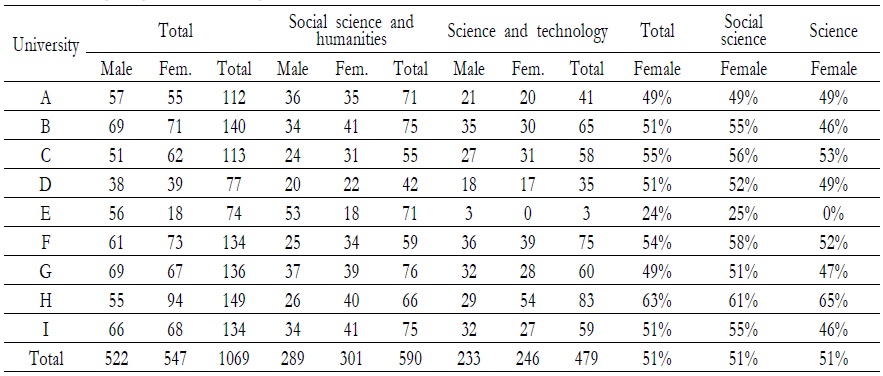
Frequency by University, Academic Discipline, and Gender
>
Gender Comparisons in the Core Competencies
The assessment of core competencies consisted of six competencies. For each competency, the score was converted and coded on a four-point scale according to pre-selected criteria. The coding scale includes poor (1), average (2), good (3), and excellent (4). Table 3 shows the mean levels of each competency for the gender groups.
Both gender groups show fairly similar patterns in their assessed level on the core competencies. Both groups scored the lowest on communication skills, followed by higher-order thinking. Information-Technology- Resources (ITR) utilization competency and global competency were at a medium level. The average assessed level of non-cognitive components (self-management and interpersonal skills) was close to 3.0, indicating good skills in these areas.
There were some gender differences observed in the data. Women scored relatively higher than men in their communication skills and global competency and relatively lower than men in their interpersonal skills, higher-order thinking, self-management, and in the processing and application of information, technology, and resources.
[Table 3] Mean Comparison between Genders
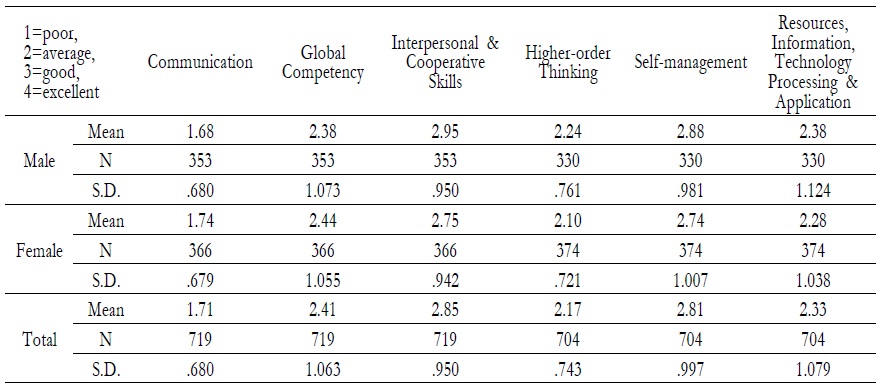
Mean Comparison between Genders
>
Gender Differences in Assessed Core Competency Levels
Table 4 shows male and female participants’ levels of the six core competencies and their sub-scores. Not controlling for the overall scores and sub-scores, gender differences between their scores was analyzed using t-tests for group mean comparison. Each competency was evaluated at one of four levels, with the levels assigned numerical values for the t-test: 1=poor, 2=average, 3=good, and 4=excellent.
[Table 4] Gender Difference in the Six Dimensions of Competency and Sub-competencies
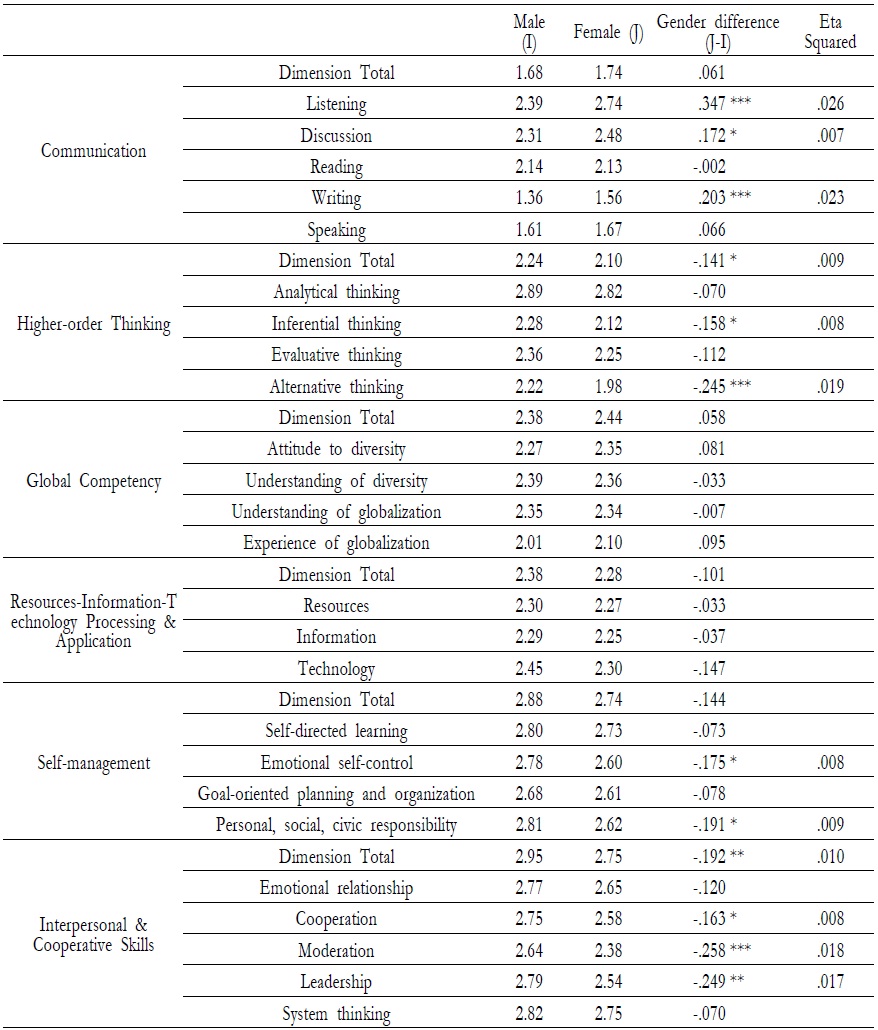
Gender Difference in the Six Dimensions of Competency and Sub-competencies
The t-test shows that there was not a statistically significant gender difference between the overall scores on communication skills but women scored significantly higher than men (p < .001) on the sub-scores of listening and writing. However, it should be noted that the effect size was small (eta squared < 0.2). Women also scored significantly higher than men on the discussion skills sub-score (p < .05). On the competency of higher-order thinking, men scored significantly higher on both the overall score (p < .01), and on two of the sub-competencies. On the alternative thinking sub-competency, men showed a significantly higher score than women (p < .001) and on the inferential thinking sub-competency, men again scored significantly higher (p < .05). On the competency reflecting the processing & application of resources, information, and technology, men scored higher than women on both the overall scores and the sub-competency scores but the differences were not significant.
On the overall global competency and the related sub-competencies, the difference between genders was not significant but, on some of the sub-competencies, men or women scored higher. On the overall score, women were slightly higher. However, in the sub-competency reflecting the attitude towards diversity and the experience of globalization, men scored slightly higher.
In the areas of self-management and interpersonal skills, men tended to score higher and, in a number of sub-sections, they showed a significantly higher level. Within the competency of self-management skills, men scored significantly higher on the sub-competencies of emotional self-management and personal, social, and civic responsibility (p < .05). Within interpersonal skills, men scored significantly higher on both the overall score (p < .01) and in the sub-competencies of coordination (p < .001), negotiation (p < .05) and leadership (p < .01).
In order to test how the disciplinary field of students’ majors affect these gender differences, a two-way ANOVA analysis method was used with a Bonferroni posthoc test. The result shows there is no significant disciplinary effect on the gender difference (p > .05).
>
Factors Affecting Core Competencies
In addition to the gender differences observed so far, other factors were accounted for, including the academic discipline of the student’s major, the university location (surrounding areas of the capital vs. other areas), the level of the parents’ income, the level of the father’s education, and the average grade point average of the previous year, as all of these factors may be related to a student’s level of psychological abilities, including both cognitive and affective aspects. For example, the parents’ income and father’s education are proxies for the socio-economic status of a student. The university location can be a proxy of institutional prestige and college admission selectiveness in South Korea where most of the national resources are centralized in the capital city, Seoul.
Multiple regression analysis was conducted to examine the relationship between these independent variables and the dependent variable by coding the independent factors as dummy and ordinal variables. The results of this analysis can be found in Table 5. Most of the gender differences found earlier were no longer significant when the above factors were controlled for except for the listening and writing sub-competencies within communication skills.
In addition to the gender differences outlined, the academic discipline of students also produced group differences. Natural and technical science students generally scored lower than social science and humanities students, and their scores were significantly lower on global competency and self-management. The score of their university entrance exam was significantly related to most of the sub-competencies of the cognitive competencies, including communication skills, higher-order thinking, and the use of resources, information, and technology. They were also significantly related to one sub-competency of global competency. Socioeconomic capital, as represented by the parents’ income, and reproduction of cultural capital, as represented by the father’s education level were found to have a weak relationship with some subsections of global competencies.
Academic achievement, as represented by the previous years’ grade point average, was not significantly related to the cognitive components of the core competencies. However, it was positively related to the definitive areas of core competencies, especially with the exposure to global atmosphere. Academic achievement also produced a significant difference in self-study, the ability to adapt to an organizational culture, and the overall score on interpersonal skills.
[Table 5] Multiple Regression Analysis of Background Influences
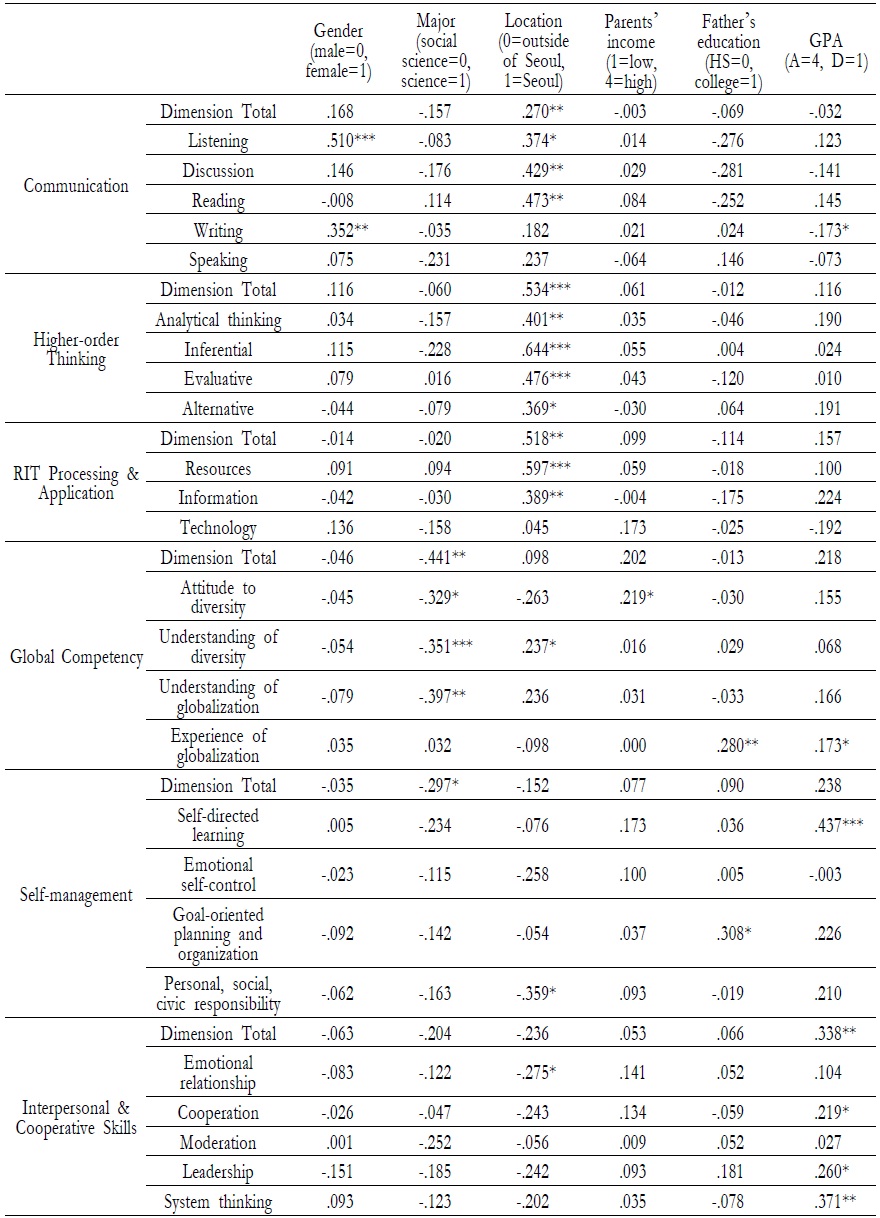
Multiple Regression Analysis of Background Influences
>
The Emphasis on Core Competencies at Higher Education
In addition to the K-CESA test questions, participating students were given a number of survey questions to report how was actively they participated in their college courses and how classroom instructions emphasized and focused on the development of the core competencies. Table 6 shows the mean score of male and female students’ responses to the questions. Higher scores indicate greater emphasis on core competencies. The average score for the education curriculum was a little higher than the midpoint of the scale. The scores did not differ much depending on the core competency being measured and there was not a significant gender difference.
[Table 6] Emphasis on Core Competencies in Curriculum
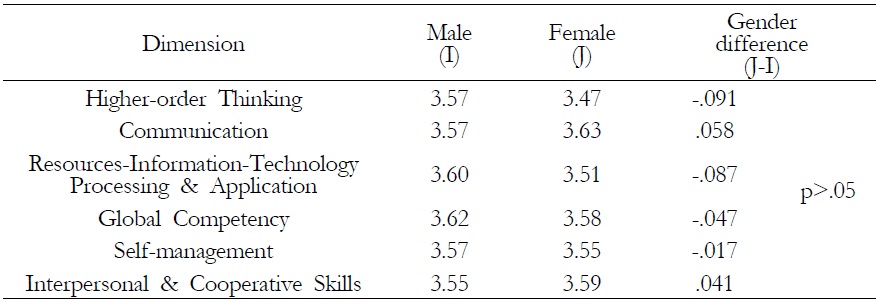
Emphasis on Core Competencies in Curriculum
However, as shown in Table 7, the students expressed that their courses did not provide enough content or methods to improve their core competencies. They found their university courses did not employ a problem-based learning environment to practice higher-order thinking and improve their utilization of resources, information, and technology. Women students were less likely to observe an emphasis on core competencies in coursework than male students.
When asked about their class participation, women responded that their participation in active interaction, discussion, experiments, and practice was low. Women were particularly lower than men in their participation in questioning, debate, and study groups, however they were more active in report writing and in the management of individual projects.
[Table 7] Core Competency Emphasis in Coursework and Participation in Classroom Activity

Core Competency Emphasis in Coursework and Participation in Classroom Activity
Table 8 shows students’ evaluation of the impact of various programs that universities provide to promote the development of core competencies. They responded that such programs such as internship and global activities in particular are beneficial for the development of core competencies. Women showed a more positive attitude towards the impact of these programs than men. Students generally expressed a positive response to the impact of specific activities of university programs on developing core competencies, especially for resume writing programs. Women tended to perceive a larger impact than did men. Women also considered vocational psychometric testing to have a greater effect than did men.
[Table 8] Student Evaluation of the Effectiveness of Developmental Activities
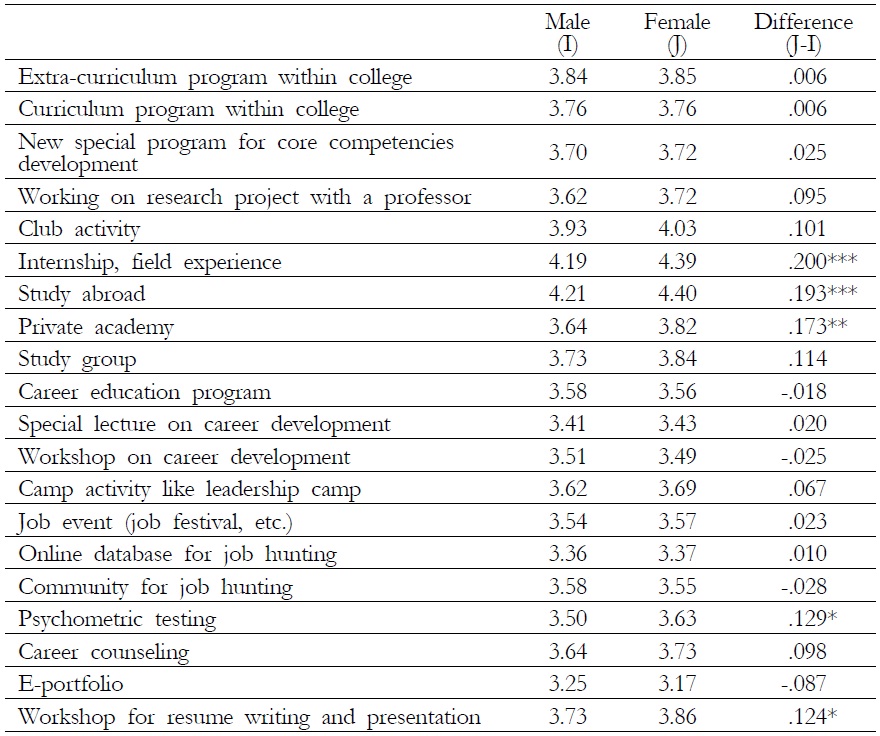
Student Evaluation of the Effectiveness of Developmental Activities
This research focused on the core competencies necessary for successful career advancement in a changing labor market. Using K-CESA, which examines the competencies of university students, women’s core competencies were analyzed and compared to men’s scores, both on the overall competency scores and on the scores of the sub-competencies. Based on the results, there are a number of important implications.
First, although the study was not conducted on a representative sample of the national student population, and these results and interpretations have limitations, the results clearly showed that both men and women were found to be lacking in communication, global competency, higher-order thinking, and resources-information-technology processing and application skills. Considering that the selected nine universities rank high in the university rankings and the competencies of their students should not be worse than that of students in other universities, the results indicate an overall deficiency of core competencies among Korean students.
Communication skills appeared particularly weak, despite being the core and basic skills demanded in work life. These skills are also extremely important for Korean students who spend much of their time reading and writing during their primary and higher education. Given the importance of communication skills, it is necessary to critically analyze and improve on the relevant education curriculum in order to enhance practical communication skills.
Second, when comparing women’s core competencies to men’s, women tended to show a lower score than men except on communication skills. However, when controlling for university and discipline of study variables, the gender difference was not significant. The reason for the non-significant gender differences could include the relatively small sample size to account for the many variables and that female students were a more self-selected group than male students due to participating universities ranking in upper-middle of the university rankings. It is impossible to find an exact cause and effect relationship with the non-experimental method that this study used. Further studies may find a causal relationship when they adopt a more representative and greater sample to include a full range of college students from both 2 and 4 year institutions across the nation. This study relied on data from students at just nine out of 166 four-year higher education institutions in Korea.
On interpersonal and cooperative skills, women’s low score provides support to previous research that revealed women’s weakness in their interpersonal skills. Strong interpersonal relationships within an organization necessitate an understanding of the organization, leadership, and conflict management. These are the skills that must be enhanced in order for women to demonstrate their full capability in this area. In order to achieve this, various educational programs must be developed and offered.
Furthermore, students in science disciplines scored lower than humanities students on their communication skills, global competency, and self-management. Given this difference between disciplines on the core competencies, students in science disciplines should be alerted that they need to develop these competencies in order to advance in their careers. Schools should also focus on core competencies, building and operating educational programs to promote the development of those competencies.
Third, the results of this study showed that students felt that their schools were emphasizing core competency development to some extent, and that their programs had a positive, but not strong, impact on their competencies. However, efforts to encourage active participation and interaction in class were considered insufficient, especially among women.
Universities must pay attention to developing core competencies through their courses and must also provide support to women so that they can develop the core competencies in ways that are most suitable for them. This empirical study clearly shows that female students demand more education relevant to core competency development than male students. This finding suggests that educators and administrators in higher education institutions need to help ease the enhanced anxiety that female students might feel, relative to male students, when they design and provide extra-curriculum programs like mentoring or coaching by female role-model figures.
Fourth, the K-CESA was completed in 2009 and began to be used towards the end of 2009. This study was the first to apply K-CESA. The scores on core competencies were consistently low, regardless of university, gender, or academic discipline. This result suggests that the competencies measured by K-CESA are different from the reading, writing, and numerical reasoning skills measured by university entrance exams. In order to validate K-CESA and ensure it is reliable, the tool needs to be applied to a greater number of universities, with analysis of the results.
Lastly, because of time and resource limitations, the sample in this study was not representative of the total college student population in South Korea, so there are limitations in generalizing the results. In further studies, a more representative sample needs to be obtained and analyzed in order to extend research into the components of the core competencies, the influencing factors, and the levels of these core competencies.
By using K-CESA to examine the competencies of university students, this study provides empirical evidence of how female students’ core competencies and demand for developmental programs are different from those of male students. Though these data and statistical analysis results have limitations, this study suggests the value of an evidence-driven policy-making process towards exploring better policy for students in higher education. While most previous literature focused on the equity between genders in college entrance and the labor market, this study extended the gender equity issue to the effect of higher education by analyzing female students’ experience with higher education curriculum and how well they acquired the core competencies.






